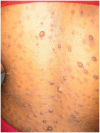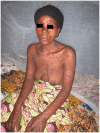Teledermatology in Low-Resource Settings: The MSF Experience with a Multilingual Tele-Expertise Platform
- PMID: 25453029
- PMCID: PMC4231841
- DOI: 10.3389/fpubh.2014.00233
Teledermatology in Low-Resource Settings: The MSF Experience with a Multilingual Tele-Expertise Platform
Abstract
Introduction: In 2010, Médecins Sans Frontières (MSF) launched a tele-expertise system to improve the access to specialized clinical support for its field health workers. Among medical specialties, dermatology is the second most commonly requested type of tele-expertise. The aim of the present study was to review all MSF teledermatology cases in the first 4 years of operation. Our hypothesis was that the review would enable the identification of key areas for improvement in the current MSF teledermatology system.
Methods: We carried out a retrospective analysis of all dermatology cases referred by MSF field doctors through the MSF platform from April 2010 until February 2014. We conducted a quantitative and qualitative analysis based on a survey sent to all referrers and specialists involved in these cases.
Results: A total of 65 clinical cases were recorded by the system and 26 experts were involved in case management. The median delay in providing the first specialist response was 10.2 h (IQR 3.7-21.1). The median delay in allocating a new case was 0.96 h (IQR 0.26-3.05). The three main countries of case origin were South Sudan (29%), Ethiopia (12%), and Democratic Republic of Congo (10%). The most common topics treated were infectious diseases (46%), inflammatory diseases (25%), and genetic diseases (14%). One-third of users completed the survey. The two main issues raised by specialists and/or referrers were the lack of feedback about patient follow-up and the insufficient quality of clinical details and information supplied by referrers.
Discussion: The system clearly delivered a useful service to referrers because the workload rose steadily during the 4-year study period. Nonetheless, user surveys and retrospective analysis suggest that the MSF teledermatology system can be improved by providing guidance on best practice, using pre-filled referral forms, following-up the cases after teleconsultation, and establishing standards for clinical photography.
Keywords: LMICs; dermatology; low-resource settings; telehealth; telemedicine.
Figures









Similar articles
-
The Development of a Multilingual Tool for Facilitating the Primary-Specialty Care Interface in Low Resource Settings: the MSF Tele-Expertise System.Front Public Health. 2014 Aug 26;2:126. doi: 10.3389/fpubh.2014.00126. eCollection 2014. Front Public Health. 2014. PMID: 25207266 Free PMC article.
-
User Feedback on the MSF Tele-Expertise Service After a 4-Year Pilot Trial - A Comprehensive Analysis.Front Public Health. 2015 Nov 20;3:257. doi: 10.3389/fpubh.2015.00257. eCollection 2015. Front Public Health. 2015. PMID: 26636057 Free PMC article.
-
Seven years of telemedicine in Médecins Sans Frontières demonstrate that offering direct specialist expertise in the frontline brings clinical and educational value.J Glob Health. 2018 Dec;8(2):020414. doi: 10.7189/jogh.08.020414. J Glob Health. 2018. PMID: 30574293 Free PMC article.
-
What is the role of teledermatology in the management of acne?Eur J Dermatol. 2024 Dec 1;34(6):616-622. doi: 10.1684/ejd.2024.4787. Eur J Dermatol. 2024. PMID: 39912467 Review.
-
[Evaluation of the tele-expertise project in the management of common dermatoses in Togo].Sante Publique. 2023 Aug 10;35(2):211-219. doi: 10.3917/spub.232.0211. Sante Publique. 2023. PMID: 37558626 Review. French.
Cited by
-
Teledermatology Evaluation and Feedback Systems: A Tool for Improving Care.Healthcare (Basel). 2023 Jun 2;11(11):1626. doi: 10.3390/healthcare11111626. Healthcare (Basel). 2023. PMID: 37297766 Free PMC article.
-
Mobile Health Strategies to Tackle Skin Neglected Tropical Diseases With Recommendations From Innovative Experiences: Systematic Review.JMIR Mhealth Uhealth. 2020 Dec 31;8(12):e22478. doi: 10.2196/22478. JMIR Mhealth Uhealth. 2020. PMID: 33382382 Free PMC article.
-
Current management of skin conditions in Kenya: exploring teledermatology preferences and perspectives among providers.Int J Womens Dermatol. 2025 Feb 6;11(1):e196. doi: 10.1097/JW9.0000000000000196. eCollection 2025 Mar. Int J Womens Dermatol. 2025. PMID: 39917274 Free PMC article.
-
Médecins Sans Frontières' Clinical Guidance mobile application: analysis of a new electronic health tool.Public Health Action. 2015 Dec 21;5(4):205-8. doi: 10.5588/pha.15.0057. Public Health Action. 2015. PMID: 26767171 Free PMC article.
-
Telemedicine in low-resource settings.Front Public Health. 2015 Jan 21;3:3. doi: 10.3389/fpubh.2015.00003. eCollection 2015. Front Public Health. 2015. PMID: 25654074 Free PMC article. No abstract available.
References
-
- Code de la santé publique – Article R6316-1. Code de la santé publique; [cited 2014 Jul 15]. Available from: http://www.legifrance.gouv.fr
-
- Mars M. Health capacity development through telemedicine in Africa. Yearb Med Inform (2010):87–93. - PubMed
-
- WHO. World Health Statistics 2013 [Internet]. WHO [cited 2014 Jul 15]. Available from: http://www.who.int/gho/publications/world_health_statistics/2013/en/
-
- Wootton R, Vladzymyrskyy A, Zolfo M, Bonnardot L. Experience with low-cost telemedicine in three different settings. Recommendations based on a proposed framework for network performance evaluation. Glob Health Action (2011) 4:7214 Available from: http://www.ncbi.nlm.nih.gov/pmc/articles/PMC3234078/10.3402/gha.v4i0.7214. - DOI - PMC - PubMed
LinkOut - more resources
Full Text Sources
Other Literature Sources
Miscellaneous

